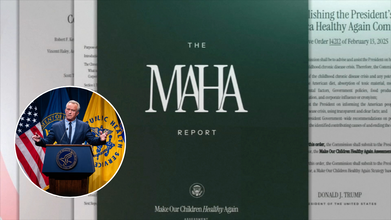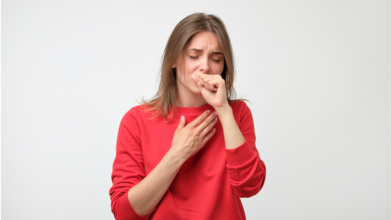- Health Conditions A-Z
- Health & Wellness
- Nutrition
- Fitness
- Health News
- Ayurveda
- Videos
- Medicine A-Z
- Parenting
- Web Stories
From Loneliness To Overstimulation: Psychologist Explains How COVID-19 Pandemic Changed Our Mental Health In 5 Years

Credits: Health and me
When COVID-19 first emerged in late 2019, few would have imagined the deep and enduring impact that it would have on our emotional and mental health. What started as an immediate public health emergency—characterized by lockdowns, travel restrictions, and social distancing—soon became a turning point in society. Streets lay empty, offices shut down, and houses became classrooms, gyms, and offices for weeks on end. While survival was the first concern—saving lives, avoiding infection—another crisis was building in the background, unobtrusively remaking the way we think, feel, and connect.
Today, five years later, the after-effects of those times continue to mold our emotional lives. Psychologist Sneha Shivarajan witnessed the transformation firsthand, working with clients across the different ages and backgrounds. What she observed is that while the pandemic years were characterized by intense stress and uncertainty, the post-pandemic era has its own multifaceted challenges.
"Grief, anxiety, and loneliness were all present prior to COVID-19," Shivarajan states, "but the pandemic thrust them into the spotlight." The collective trauma of a global health pandemic made individuals more attuned and more outspoken about unease they may have previously suppressed.
One of the most significant shifts has been the normalization of asking for help. The pre- and post-pandemic prevalence of telecounseling and virtual therapy sessions dissolved geographical and social boundaries to access mental health care. Something that began out of necessity during lockdowns has continued, as widespread global events—geopolitical turbulence, economic insecurity, environmental worry—cause individuals to continue accessing virtual realms for advice and community.
These platforms provided a safe, accessible means for people to deal with their emotional needs, and they've made discussion about loneliness and mental pressure much less stigmatized.
Also Read: Is 'Stratus' COVID Variant The Pandemic’s Next Chapter In 2025 With New Symptoms?
What Are The Emotional Patterns That Surfaced and Stayed?
Lockdowns produced a never-before-seen social experiment- roommates, partners, and families all in the same physical space together for weeks on end with no natural respite. For a few, it strengthened relationships; for others, it raised unspoken tensions.
"I’ve had clients tell me their relationship with their parents changed completely during the pandemic," Shivarajan explains. "Being around each other 24/7 brought out personality traits and habits that had never surfaced before." Conflicts that could once be avoided were suddenly unavoidable.
Meanwhile, technology became a lifeline for social connection. Virtual friendships, online romance, and remote socializing transitioned from alternative to mainstream behavior. Individuals held virtual happy hours, participated in online workouts, and even watched movies together in real-time. For many, this wasn't a temporary stopgap measure—it was the start of a new, hybrid form of relating.
The concept of "quality time" has broadened to encompass shared screens, group messaging, and hybrid experiences, where face-to-face isn't always required for closeness.
A New Generation Finding Their Way Through Identity and Overstimulation
For young adults and teenagers, the pandemic came during a critical stage in their emotional and cognitive development. With schools shut down and social life going online, their source of information burst open—ranging from climate activism to personal issues such as intimacy and mental health.
Though this stream of information is liberating, it is not without its price. "Too many young people are overwhelmed," claims Shivarajan. "They doubt themselves, fret about the future, and sometimes feel immobilized by the sheer amount of what they know."
But there's also resilience. This generation is not afraid to make their voices heard. They've embraced social media, grassroots activism, and community organizing to express themselves and call for change. The challenge is figuring out how to balance awareness with self-care, so activism doesn't spiral into burnout.
Subtle Signs of Lingering Pandemic Stress
Even for individuals who describe themselves as "back to normal," the body has a different narrative. Shivarajan cites indicators such as chronic irritability, decreased concentration, repeated illnesses, and an unshakeable feeling of restlessness as proof that unprocessed pandemic stress still lingers.
These aren't random symptoms—they're messages. "Your body is trying to inform you there's more going on underneath," she says. To acknowledge these patterns is the first step in healing, but the work is very individual.
For some, recovery might mean building a stronger social network. For others, it could involve adopting new self-care routines, scaling back on commitments, or working with a therapist. Shivarajan emphasizes that there is no one-size-fits-all solution: "Each person is the sailor of their own ship. Even if we’re all navigating the same waves, our ships are different."
The last five years have shown that mental health is not a fixed condition—it's a dynamic response to our surroundings, relationships, and global events. COVID-19 was more than an interlude; it was a profound transformation in the way we live and connect with each other.
We've transitioned from a time of solitude to one of almost ceaseless stimulation, from loneliness to Information Overload. The technology we've created—teletherapy, virtual connections, flexible work arrangements—isn't going away. But it needs to be used mindfully, so that it strengthens not degrades our well-being.
In Shivarajan's view, awareness is the key. "If the pandemic taught us anything, it's that mental health is worth prioritizing before crisis hits. We need to keep listening—to our bodies, our emotions, and to each other."
Five years later, the takeaways are obvious: loss can prompt openness, technology can close distances, and proximity—whether physical or virtual—continues to be an essential component of healing. The task now is to bring those lessons with us, constructing a culture of mental health that is long-lasting, resilient, and profoundly human.
Sneha Shivarajan is a consultant psychologist at Good Wave Foundation in India
Too Many Pills, Too Little Produce: Draft 'Make America Healthy Again' Report Blames Junk Food, Pills And Inactivity

Credits: Health and me
The US Department of Health and Human Services (HHS), under Secretary Robert F. Kennedy Jr., has been touting its “Make America Healthy Again” (MAHA) initiative as a turning point in public health. Framed as one of Kennedy’s signature achievements, the report promised bold action to address America’s chronic health crises: obesity, diabetes, heart disease, and the overprescription of pharmaceuticals.
A draft version obtained by reporters tells a different story. Instead of sweeping reforms to food, farming, or pharmaceutical regulation, the MAHA report leans heavily on additional research studies, awareness campaigns, and incremental policy suggestions. For a coalition that expected Kennedy to challenge entrenched interests—from pesticide manufacturers to Big Food—the document feels less like a revolution and more like a compromise.
What Are The Four Problem Areas?
The draft report identifies four main drivers of chronic disease in the United States:
- Poor diets dominated by ultraprocessed foods, sugars, and additives.
- Chemical exposure from pesticides and environmental pollutants.
- Lack of physical activity, worsened by sedentary jobs and urban lifestyles.
- Overuse of prescription medications, particularly among children and older adults.
These themes mirror Kennedy’s longstanding critiques of America’s health system. Yet, the policies outlined in the draft stop short of mandating aggressive reform. Instead, they recommend more studies, more definitions, and more “public awareness” campaigns.
Where the Bold Promises Fall Short In MAHA Report?
Kennedy built his reputation criticizing chemicals like glyphosate, high-fructose corn syrup, and ultraprocessed snacks that dominate the American diet. Farmers and food manufacturers braced for the MAHA report to recommend bans or new regulations. Instead, the draft calls for a public “confidence-building” campaign to reassure Americans about pesticides.
This pivot has disappointed many in Kennedy’s own coalition. Public health experts like Marion Nestle, professor emerita of nutrition at NYU, argue the draft contradicts the urgency of America’s chronic disease crisis. “The first report promised bold policies to protect children’s health. No such luck here,” she told reporters.
Industry Relief, Activist Frustration
For the agricultural sector, the draft report is a relief. It proposes partnerships with major farm companies and research into “precision technology” to help reduce pesticide use—steps that industry leaders see as constructive rather than combative.
But health advocates feel sidelined. Kari Hamerschlag, deputy director of food and agriculture at Friends of the Earth, warned that without funding, the report’s recommendations won’t translate into healthier outcomes. “This is not going to transform our food and farming system. They need to put resources behind their recommendations,” she said.
Processed Foods and the Unfinished Fight
Perhaps the biggest surprise in the draft is its limited attention to ultraprocessed foods. The MAHA movement originally spotlighted processed snacks and additives as central culprits in the nation’s obesity epidemic. But the draft only mentions that government agencies will “define” ultraprocessed foods and continue education campaigns.
Former FDA Commissioner Dr. David Kessler has argued that ingredients like refined sugars and flours should be declared unsafe. Yet the draft sidesteps any such regulatory proposals, leaving critics frustrated. Dr. Jim Krieger of Healthy Food America noted: “What about removing them from schools? Restricting marketing? Labeling packages? None of that is here.”
Research Without Teeth
The draft MAHA document devotes significant space to research priorities. It calls for the National Institutes of Health (already facing severe budget cuts under the Trump administration) to study vaccine injury, autism, infertility, prescription drug use, and nutrition. It also proposes AI-driven tools to accelerate research on pediatric cancers.
While these initiatives sound ambitious, they are contingent on funding that may never materialize. Without resources, they risk becoming yet another set of unfulfilled promises.
The Political Undercurrent
The White House has been cautious about the report’s release. A spokesperson called the draft “speculative literature” until officially endorsed. But insiders suggest the policies align closely with what was already previewed to the administration.
That alignment may explain the softened language around pesticides and ultraprocessed foods. For an administration prioritizing farmer support and deregulation, MAHA’s original vision of challenging chemical companies and processed food giants was politically untenable.
Is The New MAHA Report Building Bridges or Losing Focus?
Calley Means, one of Kennedy’s advisers, urged supporters to “build bridges” with farmers and agribusiness rather than treat them as enemies. It’s a pragmatic strategy, but critics argue it dilutes the urgency of tackling the systemic causes of poor health.
David Murphy, a former Kennedy finance director and now founder of United We Eat, framed the debate succinctly: “No one’s trying to take away farmers’ rights to grow food. We’re asking companies whose products cause harm to be held liable.” That principle, however, is largely absent from the draft.
What This Means for The People of America?
For everyday Americans grappling with obesity, diabetes, or high medical bills, the draft report offers little immediate relief. It encourages healthier diets, more exercise, and reduced reliance on medications—but without meaningful changes to food policy, medical regulation, or funding streams, these remain aspirational goals.
In essence, the report acknowledges the crises but avoids decisive confrontation with the industries fueling them. The result is a strategy that risks being too cautious to make a measurable impact.
The MAHA Commission’s final report is expected soon, but public health advocates are already voicing skepticism. Hundreds have signed letters urging the administration to address chemical exposures and ultraprocessed foods more directly. Whether those appeals shape the final draft remains to be seen.
What’s clear is that America’s chronic health problems—rising obesity, diabetes, cancer, and mental health conditions—demand more than “awareness campaigns.” Without stronger action, the “Make America Healthy Again” slogan risks becoming another empty political catchphrase.
A 4-Step Science-Backed Routine That Works for Every Skin Type

There was a time when skincare felt like a competitive sport. People layered acids, scrubbed their faces raw, and measured success in stings, peels, and redness. But times are changing. A new, science-backed wave is sweeping in, one that values results without leaving your skin feeling like it has been through a survival reality show.
From Shelf Overload to Skincare Simplicity
For years, we’ve been told more is better. More products, more steps, more actives, until our bathroom shelves looked like mini-pharmacies. But skin, much like us, thrives in balance. Aggressive routines may deliver quick wins, but they often come with side effects like irritation, dryness, or breakouts that weren’t invited to the party.The modern approach is a gentler, more measured one: using well-formulated products that are kind to the skin barrier but still pack enough punch to make a visible difference. And the best part? You only need a few steps, not a 12-item shopping list.
The Four Steps That Actually Work
Malini Adapureddy, Founder of Deconstruct Skincare, swears by a routine that’s simple enough to remember before coffee and effective enough to see results in weeks. Designed for Indian skin and climate, this four-step method covers the essentials: cleansing, treating, moisturising, and protecting.
Step 1: The Clean Slate
Every story starts somewhere, and for your skin, that’s cleansing. But the goal isn’t to strip your face like it’s a frying pan that’s just seen a masala spill. A gentle oil-control face wash with salicylic acid and niacinamide is the ticket. Salicylic acid slips into pores to keep them clear, while niacinamide calms and balances.Step 2: The Targeted Glow Shot
Once the canvas is prepped, it’s time for the serum stage. Enter a 10% vitamin C serum with 0.5% ferulic acid. Vitamin C is your radiance best friend, helping to fade pigmentation and even out skin tone, while ferulic acid boosts its stability and antioxidant power. Together, they help defend against environmental stressors and bring your complexion back from the land of dull.Unlike some actives that feel like they’re burning through your soul, this combination is gentle enough for daily use.
Step 3: The Barrier Hug
Moisturiser is often seen as the “optional” step, especially if you have oily skin. But hydration isn’t just about adding water; it’s about locking it in. A lightweight, oil-free moisturiser with natural moisturising factors (NMF) and panthenol keeps your skin barrier happy. It helps reduce sensitivity, supports repair, and works in harmony with your actives. And in India’s hot, humid, sometimes dusty climate, that’s a much-needed shield.Step 4: The Non-Negotiable
Sunscreen. Always sunscreen. Whether you’re outside chasing errands or inside chasing deadlines, UV damage is sneaky. It causes pigmentation, speeds up ageing, and undoes all the hard work your serum and moisturiser put in. A broad-spectrum, gel-based sunscreen keeps things light, non-greasy, and comfortable, even under makeup.Why Gentle Works Better Than You Think
There’s a myth that 'strong' means 'effective'. In reality, harsh products can damage your skin barrier, leaving it inflamed and reactive. Gentle formulations, when done right, work gradually but deeply. They’re like the friend who doesn’t shout advice but still changes your life.Consistency is the secret here. When your skin isn’t constantly fighting irritation, it can focus on repairing itself, building resilience, and looking better over time.
What Is Pulmonary Fibrosis and Why That Annoying Cough Might Be More Than Just a Cold

Credits: Canva
If you’ve been coughing for weeks, blaming it on “lingering winter sniffles” or chalking it up to “just getting older,” it might be time to step away from the cough syrup and lean in for some uncomfortable truth. Your cough could be more than a seasonal annoyance. In rare but serious cases, it could be a red flag for a life-limiting condition called pulmonary fibrosis.
What is Pulmonary Fibrosis?
In plain terms, “pulmonary” means lungs, and “fibrosis” means scarring. It’s a serious, progressive condition where lung tissue becomes scarred and stiff, making it increasingly hard to breathe.
Reportedly, there’s currently no cure. Treatments exist, but they mainly slow down the damage rather than reverse it. The sooner you get diagnosed, the better your chances of managing symptoms and that’s where spotting the signs early is crucial.
Symptoms to Watch For
- Shortness of breath (especially when climbing stairs or speed-walking to catch the bus)
Why That Cough Happens
Coughing is your body’s bouncer, booting out anything that might harm your lungs — dust, smoke, rogue crumbs, the works. The process involves your vocal cords clamping shut, then snapping open with a burst of air.
With pulmonary fibrosis, this reflex can get stuck on a loop. Coughing irritates the vocal cords, which makes you cough more, which irritates them further, a vicious cycle that can turn even a quiet cup of tea into a coughing fit.
The Four Flavours of Cough
- Acute cough – Lasts less than three weeks; often tied to infections or irritants.
Coughs can also be:
- Dry/unproductive – Triggered by things like temperature changes, dusty air, or laughing.
Who’s More at Risk?
While pulmonary fibrosis can happen to anyone, your risk might be higher if you:
- Are over 50
Managing the Cough
A pulmonary fibrosis cough often doesn’t respond to standard cough medicines. Instead, treatment usually focuses on easing symptoms and improving quality of life.
Your doc may recommend alternative medications used for chronic cough in other conditions. These don’t cure the scarring but can make the coughing less intrusive. They’ll also want to check for other contributing factors like acid reflux, sinus issues, or side effects from medication, because if those are making things worse, tackling them can help.
Everyday Coping Tricks
While you work with your doctor, you can try a few lifestyle tweaks to manage coughing fits:
- Avoid smoky, dusty, or heavily polluted spaces
Pulmonary fibrosis is rare, but catching it early can mean more treatment options and better management. Plus, you’ll finally know whether your cough is from a stubborn cold or something that needs closer attention. Your cough could be a harmless side effect of a dusty ceiling fan or it could be your body waving a red flag.
© 2024 Bennett, Coleman & Company Limited

